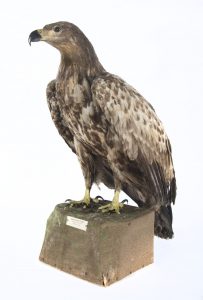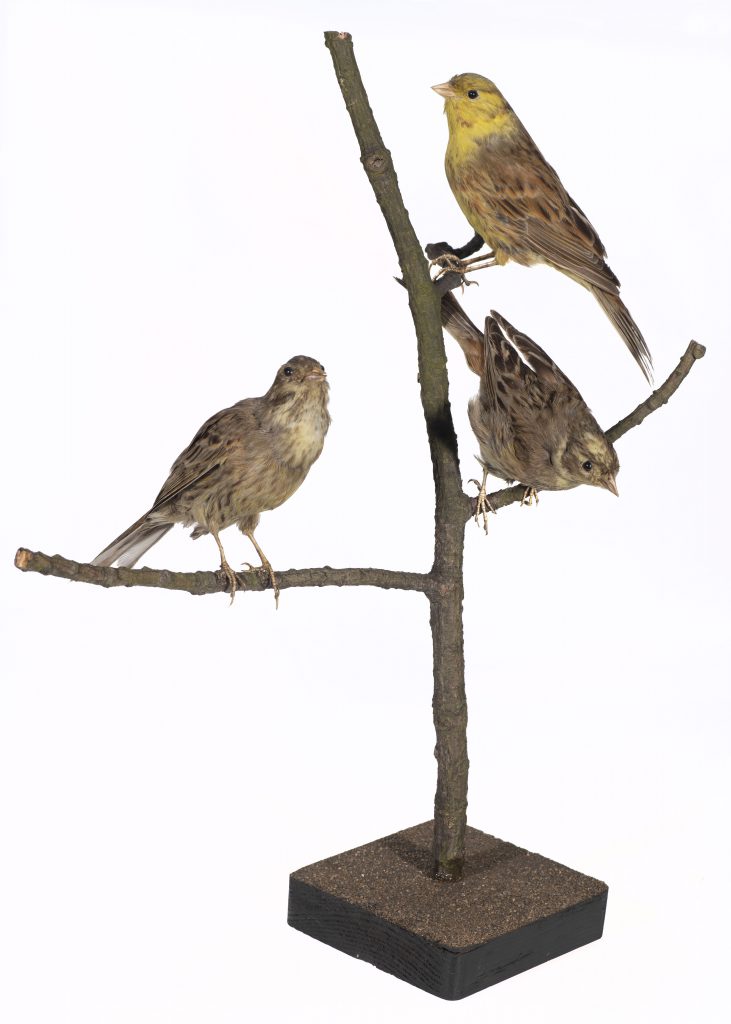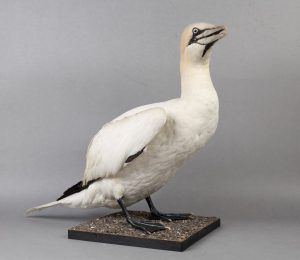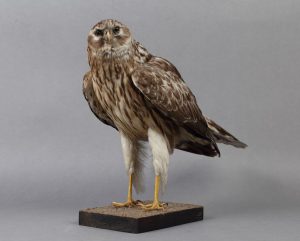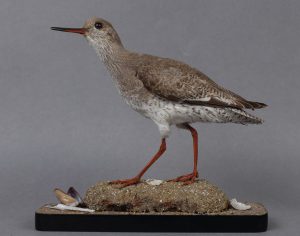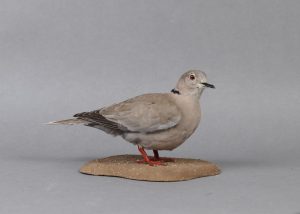EXTINCT: highlighting the plight of rare and endangered species on the Isle of Man
EXTINCT was a natural history exhibition staged at the Manx Museum from Sept 2021 to May 2022. Curated by Laura McCoy (Manx National Heritage’s Natural History Curator) in conjunction with the Manx Wildlife Trust, the exhibition highlighted the plight of rare and endangered species on the Isle of Man. The exhibition drew attention to the acute pressure on the Island’s natural environment including human impacts and climate change.
Laura says: “Extinction is forever, but there are warning signs and we can act before it is too late. There are a lot of species that have become locally extinct on the Isle of Man and are no longer found here, and some that now only visit but no longer breed. This is not the end. Unlike the Great Auk, which became globally extinct nearly 180 years ago, we can still encourage our lost species to return by helping to create nesting sites, protecting the places they find food, managing the habitats they are found or shielding them from harm.
We need to do this together, which is why organisations such as Manx National Heritage and Manx Wildlife Trust are teaming up to make a difference.”
This exhibition featured specimens from Manx National Heritage’s Natural History collections, including:
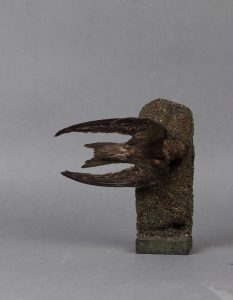
Swift (ref: 1954-1841). Scientific Name: Apus apus
There are an estimated seventy four pairs of Swifts on the Isle of Man and their numbers have declined in recent years due to the loss of nest sites in buildings, which is where they almost exclusively raise their young. You can buy nest boxes to attach to the eaves of buildings and Manx National Heritage have successfully encouraged a new colony to start at the back of our iMuseum building at the Manx Museum complex in Douglas.
Nightjar (ref: 1954-1845). Scientific name: Caprimulgus europaeus
Manx name: Ushag nu Hoie (Night Bird).
In the 19th century the Nightjar was a regular summer breeder on Mann, albeit in small numbers. Sites included Gob y Volley, Lezayre, Ravensdale, Laxey Glen,Glen Roy and Greeba until the 1930s, the Ayres until 1941, at and lastly until 1949 on its remaining site at Peel Hill.
White-tailed sea eagle (ref: 1954-1858). Scientific name: Haliaeetus albicilla.
In 1722 Bishop Wilson provided the first historical reference to this species breeding on the Isle of Man, writing that the island has ‘one airy of eagles’. This eyrie was on a precipice, 60 metres above the sea at a site known as Eairnyerey or Ernery on the steep coastal brooghs below Lhiattee ny Beinnee near Fleshwick. It is thought that the pair died in a snow storm in 1815.
The next sighting of this species was not until 1907 when this immature individual was shot at Greeba on 12th December 1907 after being pursued in the area for 2 or 3 weeks. In the early 20th century this species was exterminated from across the entire British Isles by human persecution. It is now making a comeback thanks to reintroductions in Scotland, Ireland and England. In January 2020 a young Irish-born and satellite tagged bird arrived from the Mull of Galloway on the Calf of Man before moving up the west Manx coast where the species had not been seen in two hundred years. Named Aonghus, he spent a short period here before flying to Scotland. There are currently no plans for a reintroduction.
Arctic Tern, male (ref: 1954-1986). Scientific name: Sterna paradisaea. There are an estimated fifty six pairs of Arctic Tern on the Isle of Man and their story is very similar to that of the Little Tern, meaning that they do best when we give them space so they can sit on their nests and raise their young without disturbance.
Yellowhammer (ref: 1954-2051). Scientific name: Emberiza citrinella.
Within living memory, the Yellowhammer has gone from being the most abundant bird of Manx farmland to being completely extinct on the Isle of Man. The decline of this species began in the 1960s and continued until it was lost completely within the last decade. Confusingly, the landscape of the island appears to have changed little, with small fields and an abundance of Manx sod hedges, which Yellowhammer favoured (especially those containing scattered gorse and hawthorns).
Yellowhammer mainly eat the seeds of grasses and cereal crops, but will also catch insects, particularly in the breeding season; in winter they were sustained in stubble fields, eating spilt grain. Improved farming methods, however, have resulted in a change away from winter stubbles towards winter-sown cereals, meaning fields are in-use year-round, reducing foraging areas. Declining numbers of insects are also likely to have played a role in the demise of this once common species. The last sighting in the Isle of Man was of a non-breeding bird on 30th March 2019 on the Calf of Man.
Made into taxidermy mount with one other female and one male Yellowhammer and given the number NH39.
Gannet (ref: 1954-2450). Scientific name: Morus bassanus.
Around two hundred Gannet are found fishing in Manx waters but they do not currently breed. Camden’s 1586 Britannia referred to the ‘Soland Goose’ breeding on the Calf, however, the Northern Gannet was likely lost centuries ago from either over-exploitation or the arrival of Brown Rat on the Calf in 1789.
Peregrine Falcon (ref. 1954-2453). Scientific name: Falco peregrinus.
There are now an estimated twenty five pairs of Peregrine Falcon on the Isle of Man, returning from local extinction caused by use of the now banned pesticide DDT.
Hen Harrier (ref. 1954-2462). Scientific name: Circus cyaneus.
There are an estimated 30 pairs of Hen Harrier on the Isle of Man (in 2021), which are benefitting from a lack of illegal persecution on the Island.
Redshank (ref. 1954-2558). Scientific name: Tringa totanus.
Around two hundred Redshank winter on the Isle of Man; they no longer breed at their old haunt around Langness, most probably due to disturbance.
Fulmar (ref. 1954-3498). Scientific name: Fulmarus glacialis.
The first Manx record for this bird was in 1927, with the first breeding pairs recorded below the Lower Lighthouse on the Calf of Man in 1936 (6 pairs). There are now an estimated one thousand and ninety five pairs of Fulmar on the Isle of Man, although recently numbers have fallen drastically – this number now only reflects population levels last seen in 1980, resulting in this becoming a Red-listed species.
Collared dove (ref. 1991-0002). Scientific name: Streptopelia decaocto.
There are an estimated five hundred and ninety two pairs of Collared Dove on the Isle of Man. The first Manx record for this species was on the Calf of Man on 31st May 1962 and breeding first took place north of Ramsey in 1964. Colonisation was complete around 1975.
Kingfisher, female (ref. 1998-0352). Scientific name: Alcedo atthis.
Around five Kingfisher over-winter on the Isle of Man. They no longer breed.

Sandwich Tern (ref. 2008-0158). Scientific name: Sterna sandvicensis.
Sandwich Terns no longer breed on the Isle of Man and are only seen on passage through to nest other places.
The Manx Museum is open daily from 9.30am to 4.30pm. For a full list of Manx National Heritage’s current events and exhibitions, click here. Or follow us on Facebook.



